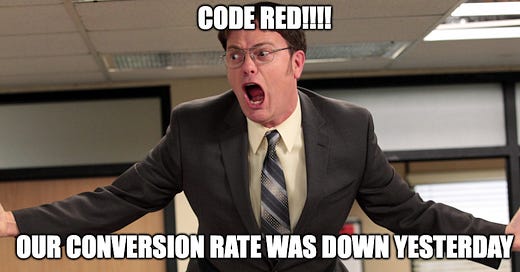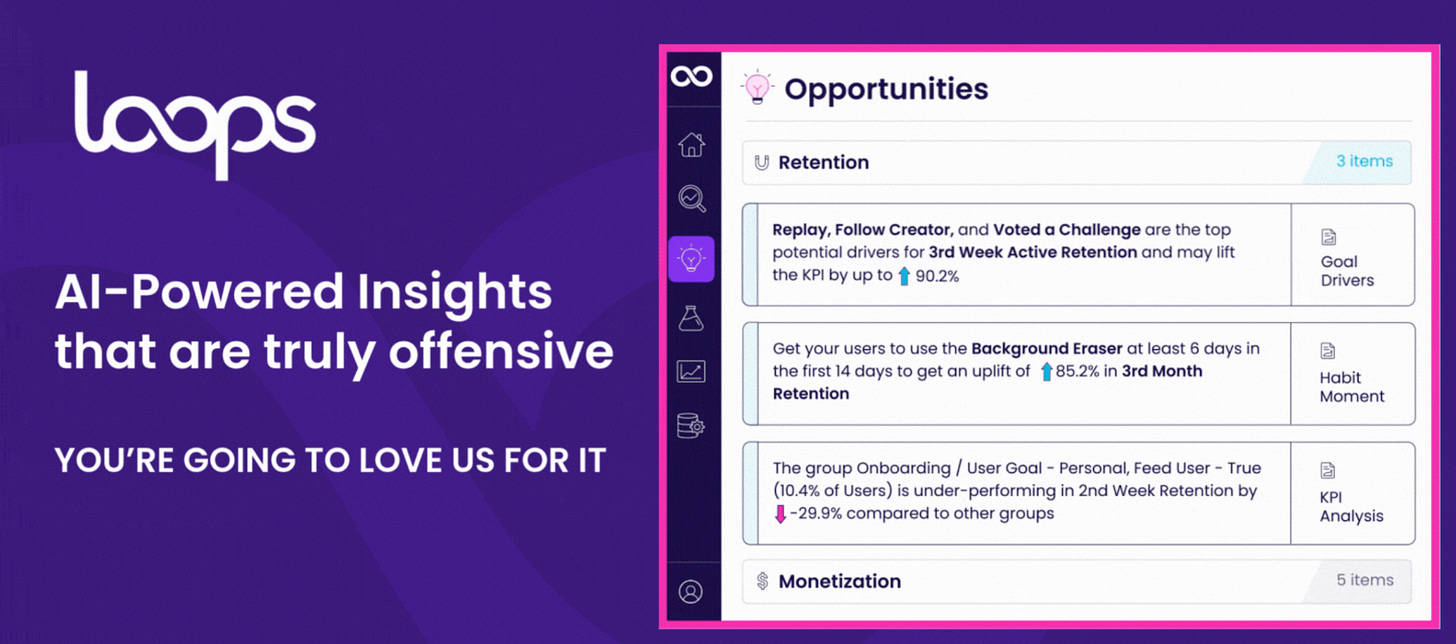This post is brought to you by Loops, balance both defensive and offensive moves with AI-Powered insights that drive breakthrough business growth. Join growth leaders - Monday.com, AB inBev, ClickUp and others - and try Loops today!
Co-written with Tom Laufer, CEO @Loops, ex. Head of Growth & Analytics @Google.
Most teams use analytics like a fire extinguisher - only pulling it out when something's on fire.
It usually goes something like this: A metric drops. No one knows why. Management goes into full panic mode.
Everyone drops everything. Analysts scramble to diagnose the root cause. Feverish Slack messages fly, dashboards are ripped apart, fingers are pointed, hot fixes are filed. Everyone’s in full firefighting mode until the numbers stabilize.
Sometimes this chaos lasts for days, blowing up everyone’s carefully planned quarter.
And half the time? The metric just bounces back on its own - no one has a clue what just happened (just writing this makes me anxious).
This is defensive analysis: reactive, chaotic, and all about damage control.
Defensive analysis is necessary. You need to know why your conversion rate dropped 20% overnight. But when this is the only way you use data, you're stuck responding to problems instead of steering toward opportunities.
Enter offensive analysis.
Offensive analysis is proactive. It doesn’t wait for a crisis. It digs into what’s already working - and finds opportunities to improve it even further. It asks:
Which cohorts or segments are outperforming the rest - and why?
Who completes this step successfully - and how are they different?
What features are sticky for high-retention cohorts - but ignored by others?
This kind of analysis surfaces hidden opportunities. It fuels experimentation backlog. It turns data into growth initiatives. It results in the step function changes to the business and the biggest wins.
Tom puts it well: “Defensive insights are the table stakes for protecting the revenue you’ve worked hard to earn. But offensive analytics - those are what drive the biggest growth. The teams that win aren’t just reacting to problems; they’re spotting the next big opportunity and turning it into a competitive edge. That’s exactly why I co-founded Loops - to help teams do just that.”
Yet most companies do little to no offensive analytics - unless their current growth levers stall out or it’s annual planning season and they need to validate a hunch. That’s far too reactive to sustain meaningful growth. The best time to do offensive analysis? When things are going well. That’s when you have the space - and the leverage - to turn small insights into big wins.
“Do defensive analysis to not get fired. But do offensive analysis to get a promotion.” -Darius Contractor, CGO @Otter.ai, ex. Head of Growth @Drift.
Why offensive analysis gets overlooked
Most companies don’t invest in offensive analytics because:
Urgency wins: Defensive fire drills always get attention.
Teams are stuck in never ending defensive mode: Some companies don't have automated process for defensive root cause analysis, so they spend too much time to manually understand why KPIs are changing.
Data as a service org: Data teams are often treated as a support function, not strategic partners - leaving them with little power or space to invest in offensive analytics.
Success is hard to attribute: It's easier to measure the fix of a short-term drop than a hypothetical future lift from an offensive insight.
Cultural habits: Many people are trained to look for what’s broken, not what’s under-leveraged. And let’s face it… everything can be perceived as broken :)
But shifting even 10 - 20% of your analytical energy toward offense can unlock huge upside. So it is not about doing more or having a larger data team - it’s about being more intentional with the time you already spend on the data.
Examples of offensive analysis
Let’s look at the real examples of offensive analytics found in the wild.
Patreon example
Shared by Adam Fishman, ex. VP Product & Growth @Patreon:
A favorite example is how we developed the “Special Offers” product at Patreon. I knew improving pledge retention - how well creators keep patrons - could significantly impact growth, even if retention wasn’t currently a problem. So I asked my data science partner to analyze all creators and identify those with steady retention who then saw a meaningful spike. That helped us isolate cases where creators were actively doing something to improve it. We studied that cohort, interviewed them, and found common patterns that led to building the “Special Offers” product. Creators who used it saw a 40–300% increase in retention, which directly boosted their earnings.
Grubhub example
Shared by Casey Winters, ex. Growth @Grubhub and @Pinterest:
We wanted to understand the impact of adding restaurants in different areas, so we analyzed how conversion rates changed based on the number of online ordering results. Each city followed an S-curve - conversion improved sharply after hitting a certain threshold of results - but that threshold varied by neighborhood. We built zip-code level reports showing online ordering results, total restaurants delivering, and orders per restaurant to identify where to grow supply. I reviewed this monthly with the VP of Sales. We also automated SEM bidding, triggering new keywords when certain neighborhood + cuisine combos reached enough results to drive strong conversion and payback.
Pinterest example
Shared by Casey:
Early Pinterest features weren’t always A/B tested, so we analyzed which features correlated with retention. We then promoted those features in the new user experience to drive adoption and boost activation - which worked. We also identified features with no correlation to activation and hypothesized that removing them could help users focus on what mattered. Simplifying the onboarding flow this way became one of our biggest activation wins.
Hubspot example
Shared by Kieran Flanagan, SVP Marketing @Hubspot
At HubSpot, we've always spent time on offensive opportunities. We've launched freemium tools to expand our digital TAM, invested more in incrementality for paid media, and bought media companies (theHustle) as a result of constantly looking for offensive opportunities that can open up new growth levers for us.
Uber example
Shared by Sundar Swaminathan, ex. Data @Uber:
After a driver told me their first trip was a chaotic Friday night, I checked the data and saw that drivers who started then had lower retention than those who started on calmer weekend afternoons. It made sense - Friday nights are intense. I recommended adjusting our comms to encourage first trips on weekend afternoons instead, and we saw significant increase to our second-trip retention.
Slack example
Shared by Fareed Mosavat, ex. Product @Slack
Our early work on monetization at Slack was almost entirely offensive. On the surface, things looked fine—paid self-serve accounts were growing year over year. But a deeper dive revealed key issues: newer cohorts were converting at lower rates, and long-tenured free users with high NPS weren’t upgrading—many didn’t even know Slack had paid plans. By instrumenting the product and improving awareness, we boosted 90-day paid conversion by over 30% and spun up a dedicated team.
Lastly, example from Google
Shared by Tom Laufer, Ex Growth & Data @Google:
At Google Photos we found that users who used “free up space” retained much better. What seemed like correlation turned out to be causal: removing storage friction made the product stickier. Promoting the feature during activation led to a big retention lift. That experience shaped how we approach analytics at Loops - offense isn’t just about insights, it’s about finding levers for future growth.
So how do you shift from defensive to offensive?
So how do you shift from defensive to offensive analysis - and make it part of your team’s rhythm?
You’ll likely need to jolt the system into a new way of working. Most orgs don’t drift toward offense naturally. Here’s how to intentionally build the muscle:
Dedicate time and space. Make offensive analytics a recurring ritual. One proven format: Monday through Thursday, analysts tackle business questions and reporting work. Fridays are reserved exclusively for offensive analysis. Then, on Monday, bring the team together to share findings, discuss implications, and offer critique. This structure forces time for exploration - and builds accountability. After all, this is the dream work for every analyst.
Pair analysts with product, growth, and marketing teams. Offensive analysis demands deeper business context than reactive work. Analysts need to be co-owners of KPIs and roadmaps - not just order-takers. This unlocks stronger insights and stronger collaboration.
Announce the shift. Make it clear that proactive, insight-generating work is now a team priority. At Gojek, Crystal Widjaja did exactly this - sending a company-wide message to declare the change (see her actual email here).
Map out the gaps. Crystal also introduced a living doc titled "Decisions we see being made without data." You can’t influence decisions if you don’t know where they’re being made, so this helped create transparency around where the data team could inform the outcome.
Source ideas org-wide. Launch a lightweight intake form asking people across the org: “What part of the product, funnel, or experience do you wish we understood better?” You’ll discover patterns very quickly.
Create a forum for offensive insights. Don’t let great ideas get buried in backlogs. Carve out space to share them: think weekly growth meetings, monthly data science fairs, or a dedicated “insight of the week” ritual. Tom Laufer at Google even kicked off weekly insights reviews. When analysts know their ideas will be seen, they’ll bring their best.
Push beyond the insight. The most valuable analyses don’t stop at "what" - they offer a "now what." Every insight should come with a suggestion, ideally a rough spec, prototype, or opportunity sizing. Analysts who propose action - not just observation - earn more influence.
Celebrate offensive wins. Don’t just applaud the fix that stopped the bleeding. Highlight the insight that led to a lift. Treat offensive wins like product launches - they deserve the spotlight.
Offensive analytics takes a cultural reset. But once it’s in motion, it compounds. You stop reacting to problems - and start unlocking growth before anyone else even sees the opportunity.









That's some serious offensive writing 👏
Great concept! Much better than proactive vs reactive